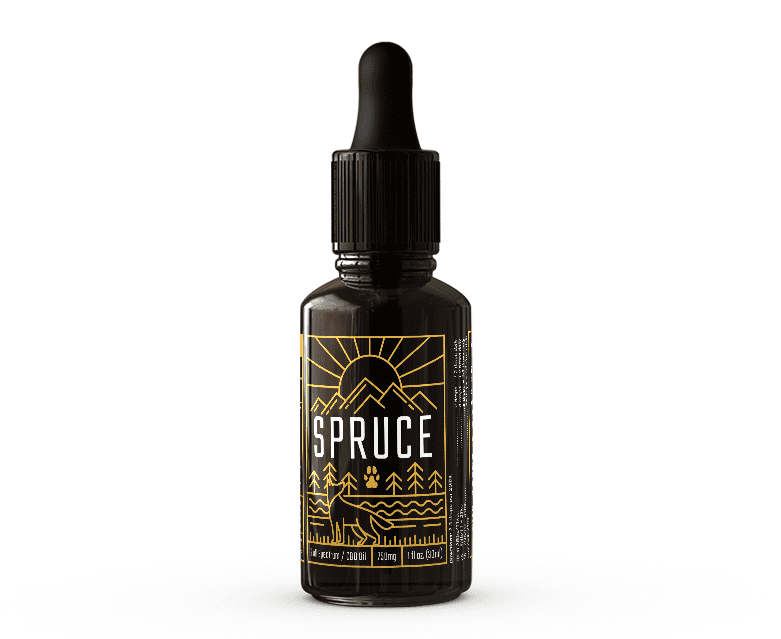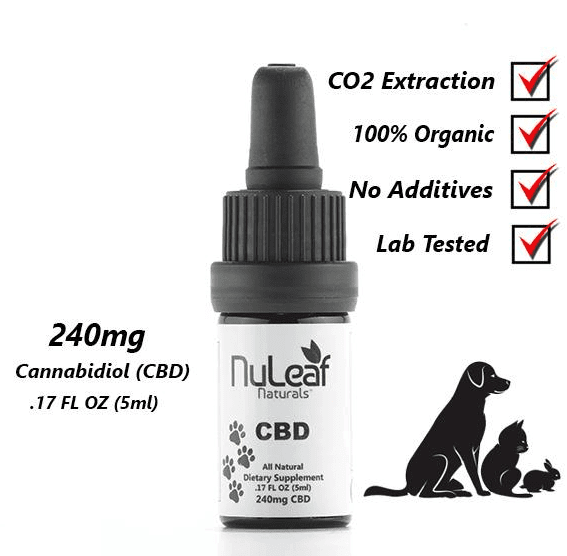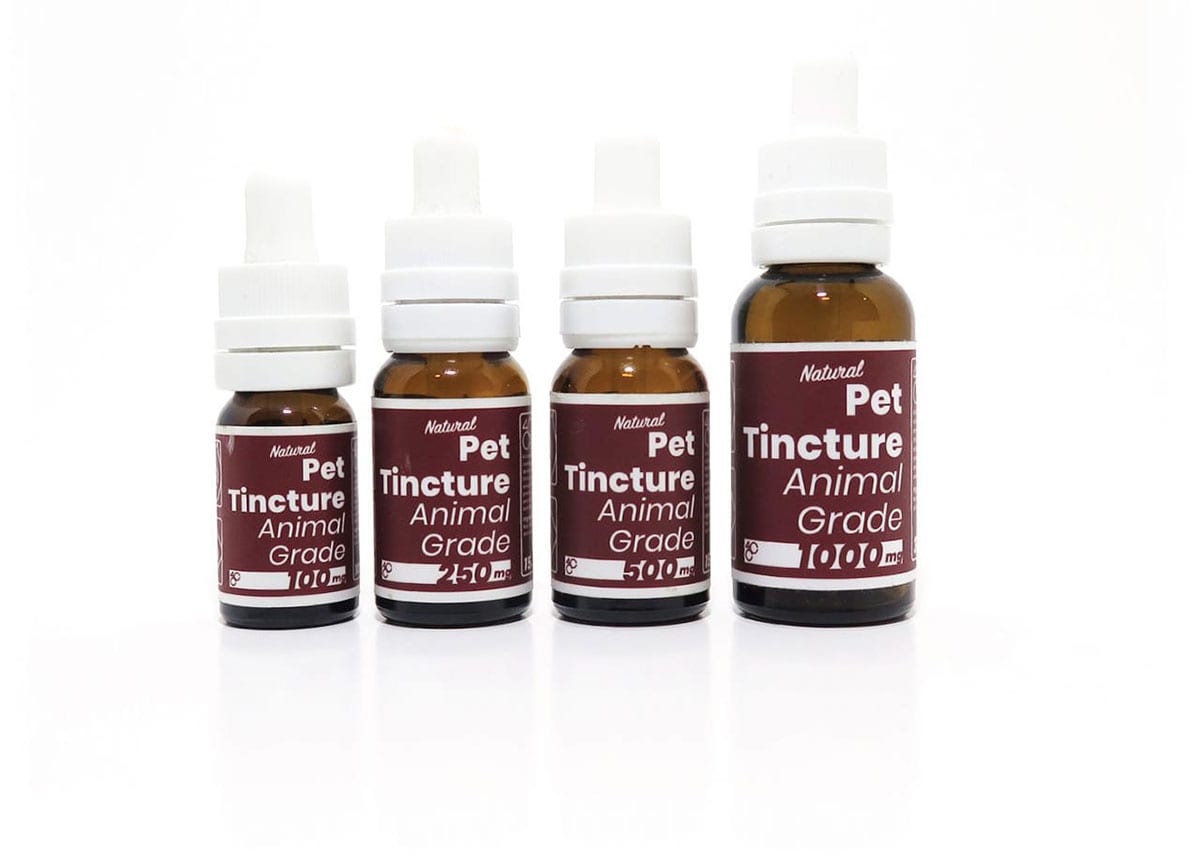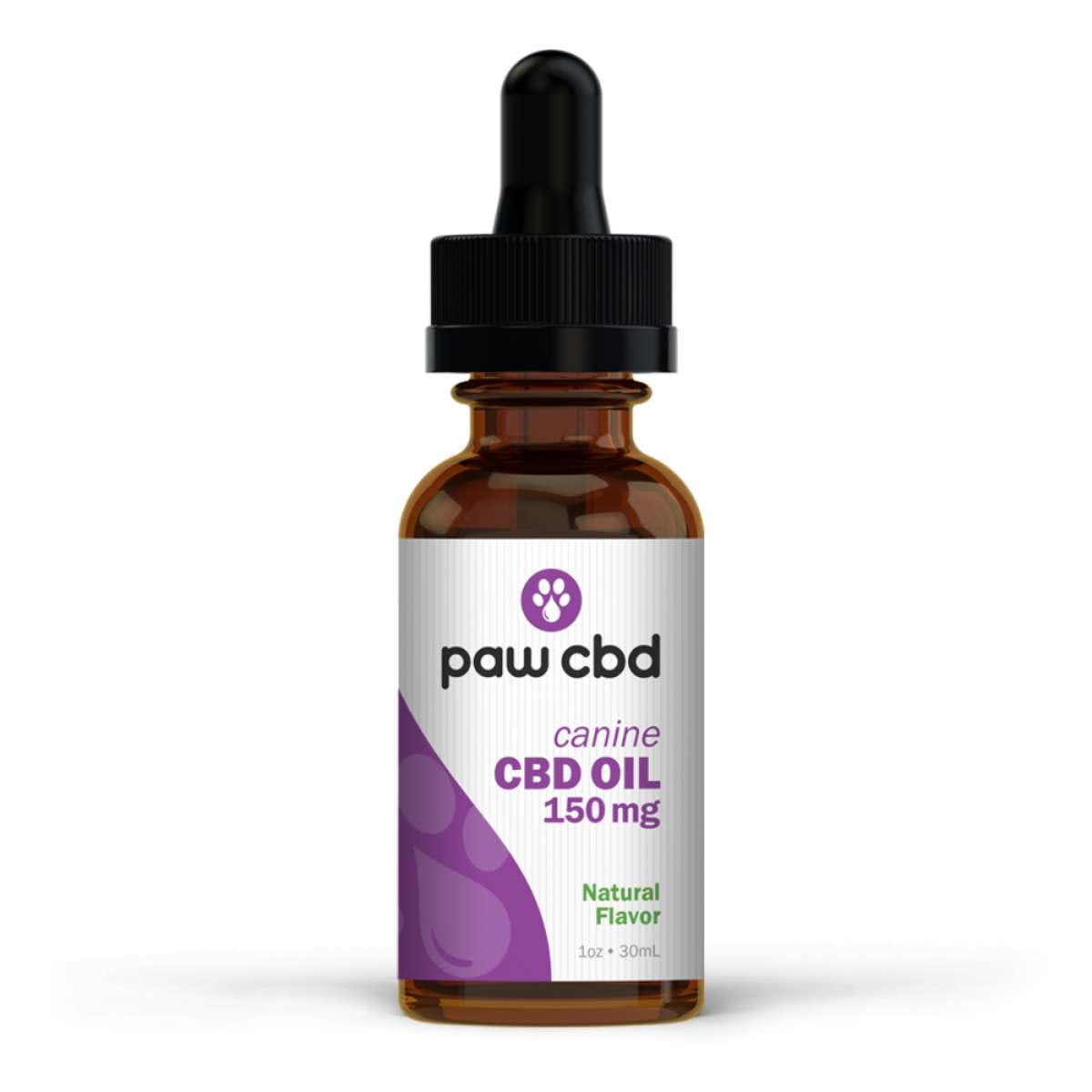Best CBD Oil for Dogs
With cannabidiol (CBD)’s purported calming effects for dogs, you may want to consider CBD oil for your furry friends’ overall wellness. If you want to introduce your pet dogs to high-quality CBD products, check out some of the best CBD oil for dogs listed below.
Best CBD Oil for Dogs 2025
- Spruce Dog CBD Oil 750mg Best Overall
- Honest Paws Wellness Oil for Dogs Best Immunity Support for Dogs
- Nuleaf Naturals Pet CBD Oil Best Organic
- 4 Corners Cannabis Pet Tincture Best High Potency
- cbdMD Pet CBD Oil Tincture for Dogs Best Range
Compare the Best CBD Oil for Dogs
Best CBD Oil for Dogs
1. Spruce Dog CBD Oil 750mg
cbdc overall score
4.8
CBDC Evaluation Table/Score
| Pros | Cons |
|---|---|
|
Same as human lab grade, full spectrum CBD oil |
No other flavors |
|
Easier on Dog's digestion |
|
|
Made from 100% organic and natural ingredients |
Overview
Spruce’s dog-friendly CBD has been specially formulated for dogs. Instead of hemp seed oil for the carrier oil, the product contains coconut oil, which is generally easier on the digestion for dogs. The taste is also milder with no flavorings, making it more likely that dogs will eat it with their food.
Using Spruce CBD for dogs is simple. All owners have to do is sprinkle the desired dose on the dog’s food at mealtime once or twice a day. Each dose should consist of about two to three drops per 20 pounds of dog weight.
2. Honest Paws Wellness Oil for Dogs
cbdc overall score
4.1
CBDC Evaluation Table/Score
| Pros | Cons |
|---|---|
|
Product offering is extensive |
Most products were not tested for solvents or mycotoxins |
|
Products are made from 100% organic, non-GMO, and locally grown hemp |
Limited information on the company |
|
30-day money-back guarantee |
Available in the US only |
|
Free shipping for orders over $49.95 |
|
|
Expedited delivery option is available |
Overview
A calming full-spectrum hemp oil that combines naturally occurring CBD with other ingredients for healthy immunity, calm moods, and a healthy brain.
3. Nuleaf Naturals Pet CBD Oil
cbdc overall score
5.0
CBDC Evaluation Table/Score
| Pros | Cons |
|---|---|
|
Pure CBD hemp |
No other flavors |
|
All natural |
Overview
CBD for dogs, cats and other four-legged friends! Our product is concentrated to approximately 50mg cannabinoids per milliliter of oil. While this product is designed for pets, it’s great for humans, too.
4. 4 Corners Cannabis Pet Tincture
cbdc overall score
5.0
CBDC Evaluation Table/Score
| Pros | Cons |
|---|---|
|
Has a wide variety of CBD strengths |
A bit expensive |
|
Free shipping on $100 and up |
Incomplete lab test results |
Overview
4 Corners Cannabis Pet Tinctures are generous on their options since there are different sizes and strengths available for you exact needs. The flavor peanut butter is available perfect for pets who are picky when it comes to eating.
5. cbdMD Pet CBD Oil Tincture for Dogs
cbdc overall score
3.6
CBDC Evaluation Table/Score
| Pros | Cons |
|---|---|
|
Same CBD Oil benefits as for humans |
Low terpene and cannabinoid profile |
|
No THC Animal-specific products (dogs, cats, horses) |
|
|
Made from premium CBD from non-GMO USA hemp |
Overview
With nothing but MCT oil combined with CBD oil sourced from U.S. hemp that is grown using organic farming methods, these CBD Oil Tinctures for Dogs can be added to their favorite foods while still providing the same effects that you enjoy. We have two flavors to choose from: Natural and Peanut Butter.
How Does CBD Help Dogs?
CBD works its purported anti-anxiety(1) and anti-inflammatory properties(2) through the body’s endocannabinoid system (ECS), which exists in all animals except insects(3).
The ECS modulates body organ systems and the immune and nervous systems through a complex receptors system and chemical signaling molecules.
Additionally, the ECS relieves pain and inflammation, regulates metabolism and neurologic function, supports reproductive function and embryologic development, and promotes healthy digestive processes.
CBD, tetrahydrocannabinol (THC), and other cannabinoids produce the organ system effects and cellular effects of cannabis by interacting with the CB1 and CB2 receptors(4).
A 2019 study focusing on the ECS of animals mentioned that the CB1 receptors’ structure is similar among all mammalian species(5).
CB1 receptors inhibit neurotransmitter release and are primarily located in neurons. These receptors play a role in memory processing, motor regulation, appetite, mood, sleep, and pain sensation(6).
Meanwhile, CB2 receptors are concentrated in the immune cells. CB2 receptors modulate cell migration and the release of cytokines (proteins that the immune system produces).
A 2018 PLOS One publication on the ECS in canine inflammatory central nervous system (CNS) diseases explained the modulation and release process(7). The authors indicated that many medicinal properties of cannabinoid compounds are attributable to CB2 receptors.
The Journal of Neuroinflammation published a study in 2017, showing that CB2 receptors help with chronic inflammatory processes and modulate chronic pain(8).
Meanwhile, data from a research article published in the Journal of Pharmacology and Experimental Therapeutics proposed that CBD may induce apoptosis in cancer cells partially via direct or indirect activation of the CB2 receptor(9). Results indicated that CBD could be a potent inhibitor of cancer cell growth.
Despite the promising effects of CBD, it has yet to be proven as a complete treatment method for any canine disorder or ailment.
The overall safety and potential risks of using CBD for dogs have yet to be researched thoroughly. The American Kennel Club (experts in dog information) advises pet owners to always seek professional veterinary advice before giving their dogs CBD(10).
Benefits of CBD Oil in Dogs
Dog owners may want to consider using CBD products in place of anti-inflammatory medications. This option is viable as anti-inflammatory drugs share the same metabolic pathways as cannabinoids(11).
In 2017, Cornell University conducted a study to demonstrate CBD’s anti-inflammatory benefits in dogs with osteoarthritis(12).
Researchers observed that the dogs were relieved of inflammatory and osteoarthritic pain after receiving a specific CBD dosage twice a day(13).
The Veterinary Science Development had previously published a study highlighting that one in every four dogs in the US suffered from some form of arthritis(14). This statistic makes CBD’s impact on osteoarthritic pain among dogs substantial.
The study attributed the pervasiveness of arthritis in dogs among all domestic animals to several factors, including injury, excessive running or physical activity, and genetic predisposition(15).
Apart from providing arthritic dogs with significant osteoarthritic and inflammatory pain relief, the 2017 Cornell University study noted that hemp CBD dog treats appear to soothe other symptoms, such as gastrointestinal issues and pruritus (itching)(16).
The Neurochemical Research Journal reported that CBD might suppress serotonin’s reuptake in the brain(17). Serotonin is vital in influencing behavior and moods, making individuals associate it with being a “feel good” chemical that reduces anxiety and evokes happiness.
The suppression of serotonin reuptake is the absorption through a presynaptic nerve ending of a neurotransmitter that it has secreted, making serotonin readily available for the body(18).
Meanwhile, the results of a 2019 study in The Journal of Neuroscience observed that the effects of increased anandamide levels in the brain are associated with a reduction of fear, stress, and anxiety(19).
The symptoms of anxiety in dogs may be caused by what the animals perceive as stressful situations and events.
Such occurrences may include being in crowded, noisy, and unfamiliar places, thunderstorms, separation anxiety, or spending long hours on the road when being taken to distant locations.
What CBD Products Are Available for Dogs?
There are CBD products available for dogs, including CBD pet tinctures for oral administration or transdermal application through massages.
Owners may combine unflavored pet CBD tinctures with their pet’s food to create a superfood or opt for CBD pet treats.
Other CBD product options for pets include CBD topical balms or creams. Dog owners may use these products to help manage their dog’s muscle aches or rashes.
Dog owners must start dosing with a minimum amount mentioned on the label, gradually increasing the dosage until the target dose for their dog is reached(20). This reminder is crucial when administering pet CBD oil tincture to a dog for any health issues.
How to Administer CBD Oil to Dogs
CBD oil tincture products usually come with a marked dropper. This tool is necessary for consistent and accurate dosing. Dog owners must be keen about how much CBD is contained in each drop or milliliter of oil tincture given to pets.
Pet owners may prefer to mix oil tinctures into their dog’s food or incorporate a few drops into their dog’s favorite treat, such as peanut butter.
Conversely, dog owners may choose CBD treats and soft chews to give their dogs. This method of administration ensures a fixed amount of CBD intake.
The amount of CBD that dogs require to achieve maximum purported benefits is dependent on the dog’s breed, age, size, diagnosis, and other existing medical conditions. Large dogs may experience the effects differently compared to smaller species.
Upon CBD administration, dog owners must report to the veterinarian in charge of their pet’s therapy their pet’s progress, behavior, and reactions.
What Dosage Does the Dog Need?
Currently, there is no standard CBD dosage chart or guide for dogs. The FDA has not yet approved CBD’s use on dogs or any animal.
Although humans can tolerate high doses of CBD well(21), giving dogs the same amount of CBD as their human owner might use is not advisable.
The common consensus among CBD users and dog owners is that the dosage should depend on the animal’s body weight, including the seriousness of the animal’s medical condition.
A study that the Colorado State University conducted in 2017 noted that the administration of 2mg CBD per kilogram of a dog’s body weight may increase the subjects’ comfort and activity(22).
Veterinary Cannabis Education and Consulting also provides pet parents with guidelines on the proper CBD dosage(23).
The guide advises pet owners to “go slow” when administering CBD to their pet animals. It recommends beginning with a low dose and gradually increasing it until CBD’s effects are achieved.
The safest option for dog owners who are unsure about their pets’ appropriate dosage is to follow the dosage instructions that the CBD brand or manufacturer provides.
Every reputable CBD company must have its own specialized CBD dosage chart and guide. The guide should have all the information regarding the CBD amount in each pet treat or product.
High-quality CBD oil dog treats are likely to contain a consistent amount of CBD in each treat. This consistency makes it more comfortable for dog owners to administer CBD for their pet dogs.
Most CBD companies indicate that more potent doses are intended for severe medical conditions. Meanwhile, regular doses are for boosting a dog’s overall health and well-being.
CBD is not a cure for any medical condition that a dog may have. Pet owners must seek the professional opinion of veterinarians before administering CBD pet products to their dogs.
How Soon Can CBD’s Effects Be Felt?
Specific research on the effectiveness of CBD among dogs is minimal. However, as observed in human studies, the sublingual administration of CBD oil may take between 30 minutes to an hour before the user feels its effects.
Through sublingual administration, CBD avoids passing through the liver by going through the mucous membranes(24).
Meanwhile, a 2010 study showed that peak blood levels of most substances taken sublingually are achieved between 10 to 15 minutes. Additionally, the sublingual application allows the body to absorb a more significant percentage of a dose than ingesting CBD directly(25).
The effects of CBD may vary depending on the method of taking the substance. Additionally, note that most studies on the impact of CBD involve humans and mice, not dogs.
Still, human patients who take CBD oil sublingually may continue to feel the effects between four and six hours. A study noted that CBD remained in effect for up to four hours after the CBD was administered through a capsule(26).
There is currently a lack of longitudinal research specifically among dogs to support CBD’s purported positive effects.
Risks of Using CBD for Dogs
The United States Food and Drug Administration (FDA) does not approve the marketing of CBD products as dietary supplements or medicine(27). The FDA is responsible for ensuring the efficacy, safety, and security of drugs for human and animal patients to protect public health(28).
There is limited evidence to support CBD’s claim as a viable treatment for specific debilitating conditions. CBD only has significant scientific backing to treat seizures associated with Lennox-Gastaut syndrome or Dravet syndrome in children over one year old.
The FDA has only approved Epidiolex as a CBD treatment for children who experience seizures caused by rare and severe forms of epilepsy. Epidiolex is the first FDA-approved drug containing an active ingredient derived from marijuana plants(29).
The American Veterinary Medical Association (AVMA) clarifies that veterinarians may similarly prescribe Epidiolex for animals under the Animal Medicinal Drug Use Clarification Act (AMDUCA)(30).
However, the FDA has not approved the use of cannabis and cannabis-derived products in animals. The agency advises owners to consult with their veterinarians before administering cannabis products to address any symptoms of illnesses among animals(31).
As of 2019, only veterinarians based in California have the authority to discuss cannabis use in animals(32).
Precautions When Using CBD Oil Additives in Dogs
Dog owners must consider the legal precautions when using CBD oil products for their dogs.
However, there is lacking scientific research done in most states, limiting most veterinarians from exploring various naturally derived alternatives for animal treatment and overall wellness.
Also, CBD documentation notes that the compound potentially causes side effects in dogs, including dry mouth, nausea, diarrhea, low blood pressure, and drowsiness(33). These side effects most likely occur when CBD products are of low quality.
As such, Veterinary Cannabis Education and Consulting published the following guidelines to help dog owners select and ensure that owners purchase the highest quality products made with natural ingredients for their dogs(34):
- Acquire important information on cannabis laws that apply in the location where you intend to make the purchase. Pure CBD products from hemp plants are available in physical and online pet stores.
- Selecting CBD products that utilize over 600 compounds of the whole cannabis plant is advisable. These products are reportedly safer and more effective than products that only contain fewer compounds(35).
- Actively seek products that have passed rigorous third-party lab tests. Reputable brands, such as Honest Paws and NuLeaf Naturals, carry clean CBD products without harmful contaminants, such as pesticides, bacteria, mold, solvents, and heavy metals.
Lab results are available in a product’s certificate of analysis (COA), which reputable brands provide on their website. CBD contents on a product label that match its COA proves that the company has undergone appropriate lab testing for its products.
Test results in COAs may also confirm whether a product is GMO-free or gluten-free. Non-GMO hemp products contain no additives and have no genetically modified ingredients, ensuring that pet owners purchase the best CBD oils for dogs and best organic CBD products. - For utmost safety, pet owners must purchase CBD products that undergo either alcohol extraction or CO2 extraction instead of other extraction methods that leave behind toxic residues.
- Verify if the CBD company formulates the products it offers in a high-quality oil base rather than the potentially harmful alcohol base. Carrier oils typically come in MCT oil, coconut oil, hemp seed oil, and olive oil.
- Avoid CBD products that include additives, such as artificial coloring and preservatives.
- Select CBD products containing the federally legal amount of THC (less than 0.3%) to avoid giving dogs the euphoric properties of cannabis.
THC levels of full-spectrum CBD oil products typically are within this limit. Meanwhile, broad-spectrum CBD and CBD isolate products are THC-free.
Full-spectrum hemp oil contains the full range of cannabinoids, terpenes, and fatty acids, such as omega-3, that occurs naturally in hemp plants. The combination of all components delivers the purported effects of CBD through a mechanism called the entourage effect.
Legality of CBD
Only 47 out of the 50 states in the USA have allowed CBD with varying degrees of regulation per state(36). According to federal laws, people may travel with CBD through different states with similar CBD possession restrictions and usage limitations.
The US typically associates CBD’s legality with the 2018 Farm Bill or the Agriculture Improvement Act of 2018(37). This law declassified organic hemp plants as marijuana plants, thus removing them from the Schedule I category of the 1970 Federal Controlled Substances Act(38).
Before the 2018 Farm Bill’s passage, both hemp and marijuana belonged under the Schedule I drugs category, which consisted of potentially abusive or addictive substances with no recognized health benefits.
Cannabis sativa plants may come from hemp and marijuana varieties. The 2018 Farm Bill redefined hemp plants as cannabis plants that contain less than 0.3% THC on a dry weight basis. Meanwhile, marijuana plants are cannabis plants that have more than the established limit.
Apart from the redefinition of industrial hemp plants based on their THC content, the 2018 Farm Bill granted the FDA permission to regulate CBD’s circulation in the market(39).
The agency reserves the right to penalize CBD companies that make unproven claims about CBD oil products’ therapeutic effects and benefits.
CBD and THC are the most abundant naturally occurring cannabinoids in cannabis plants, meaning both compounds are present in both hemp extracts and marijuana extracts.
The difference in THC concentrations implies that CBD oil derived from a particular plant does not make its users feel any psychoactive effects.
The 2018 Farm Bill removed legal restrictions from owning hemp products. Local laws may still supersede federal law since state laws are the primary enforcement authority in drug-related offenses(40).
Product Frequently
Asked Questions
-
How can CBD help with dogs?
CBD interacts with dogs’ ECS to help with multiple conditions, including a dog’s anxiety, pain, and inflammation(41).
Although the ECS exists in humans and all mammals(42), the amount of CBD in products meant for humans may contain too much for a dog to handle. As such, the administration of human CBD oil to dogs is inadvisable.
-
What evidence or existing research says that CBD helps with dogs?
Cornell University conducted the first study on CBD oil for dogs in 2017. Researchers administered CBD oil to dogs with osteoarthritis to demonstrate CBD’s potential anti-inflammatory properties(43).
-
Is there any evidence that CBD worsens dogs' conditions?
Some documentation only states that CBD potentially causes side effects in dogs, including dry mouth, nausea, diarrhea, low blood pressure, and drowsiness(44).
While there is no definitive proof of a dog’s conditions worsening upon CBD administration, pet owners must remember that CBD is not a medicine and must not treat it as such.
-
Does CBD interact with any current medications dogs may be taking?
Some existing tests only report the potential adverse effects associated with the administration of CBD in healthy dogs. More longitudinal research needs to consider possible drug interactions through CBD’s clinical usage(45).
-
How much CBD oil can dogs take?
There currently is no standard CBD dosage chart or guide for dogs. Furthermore, the FDA has not yet approved the use of CBD on any animal, including dogs.
Dog owners’ common consensus is that the CBD dosage should depend on their dog’s body weight and the intensity of the animal’s medical condition.
Professionals at ASPCApro (a resource for animal welfare professionals) state that various safety studies have shown how CBD may cause dose-dependent elevations in liver enzymes(46). Although professionals have not reported this observation in acute overdose situations, it could harm or kill pets taking CBD long-term.
-
Is CBD oil safe for dogs?
Although studies conducted on arthritic dogs generally observed no side effects, longitudinal research is required to substantiate whether CBD oil helps promote safety and wellness in dogs.
-
Can dogs use CBD oil for arthritis?
The first scientific research for CBD oil use in pets is the 2018 study sponsored by Cornell University, which involved the administration of CBD oil to dogs with osteoarthritis(47).
The study’s results mentioned that organic CBD oil may increase the dogs’ activeness and relief. Since CBD shares metabolic pathways with anti-inflammatory drugs, it may also help with other canine inflammatory conditions(48).
-
How long does it take before CBD takes effect in dogs with joint pain?
The effects of CBD oil in dogs may vary depending on the dosage given to them, aside from other factors.
The existing research on CBD oil for the treatment of osteoarthritic dogs spanned four weeks(49). It is only safe to assume that CBD’s effects manifest within the period of clinical tests.
-
How long does CBD’s effects on dogs last?
CBD’s effects may vary depending on your dog’s breed, dog’s size, dog’s weight, and preexisting health conditions. There is currently no way to find out how long precisely CBD’s effects last in dogs.
- Russo, E.B., Burnett, A., Hall, B. et al. (2005). Agonistic Properties of Cannabidiol at 5-HT1a Receptors. Neurochem Res, 30, 1037–1043. https://doi.org/10.1007/s11064-005-6978-1.
- Gamble LJ, Boesch JM, Frye CW, et al. (2018 July 23). Pharmacokinetics, Safety, and Clinical Efficacy of Cannabidiol Treatment in Osteoarthritic Dogs. Front Vet Sci., 5:165. DOI:10.3389/fvets.2018.00165.
- Silver R. J. (2019). The Endocannabinoid System of Animals. Animals : an open access journal from MDPI, 9(9), 686. https://doi.org/10.3390/ani9090686
- Soderstrom K, Soliman E, Van Dross R. Cannabinoids Modulate Neuronal Activity and Cancer by CB1 and CB2 Receptor-Independent Mechanisms. Front Pharmacol. 2017;8:720. Published 2017 Oct 10. doi:10.3389/fphar.2017.00720.
- Silver RJ. The Endocannabinoid System of Animals. Animals (Basel). 2019;9(9):686. Published 2019 Sep 16. doi:10.3390/ani9090686.
- ECHO. (2017, April 18). Retrieved from https://echoconnection.org/look-endocannabinoid-systems-cb1-cb2-receptors/.
- Freundt-Revilla J, Heinrich F, Zoerner A, et al. The endocannabinoid system in canine Steroid-Responsive Meningitis-Arteritis and Intraspinal Spirocercosis. PLoS One. 2018;13(2):e0187197. Published 2018 Feb 6. doi:10.1371/journal.pone.0187197.
- Niu J, Huang D, Zhou R, et al. Activation of dorsal horn cannabinoid CB2 receptor suppresses the expression of P2Y12 and P2Y13 receptors in neuropathic pain rats. J Neuroinflammation. 2017;14(1):185. Published 2017 Sep 12. doi:10.1186/s12974-017-0960-0.
- Alessia Ligresti, Aniello Schiano Moriello, Katarzyna Starowicz, Isabel Matias, Simona Pisanti, Luciano De Petrocellis, Chiara Laezza, Giuseppe Portella, Maurizio Bifulco and Vincenzo Di Marzo. Antitumor Activity of Plant Cannabinoids with Emphasis on the Effect of Cannabidiol on Human Breast Carcinoma. Journal of Pharmacology and Experimental Therapeutics September 1, 2006, 318 (3) 1375-1387; DOI: https://doi.org/10.1124/jpet.106.105247.
- Kriss, R. (2019, Oct 27). CBD Oil for Dogs: What You Need to Know. Retrieved from https://www.akc.org/expert-advice/health/cbd-oil-dogs/.
- MedlinePlus. (2020 January 21). Cannabidiol (CBD). Retrieved from https://medlineplus.gov/druginfo/natural/1439.html.
- Gamble LJ, Boesch JM, Frye CW, et al. (2018 July 23). Pharmacokinetics, Safety, and Clinical Efficacy of Cannabidiol Treatment in Osteoarthritic Dogs. Front Vet Sci., 5:165. DOI:10.3389/fvets.2018.00165.
- Ibid.
- Bland, Stephanie. (2015). Canine Osteoarthritis and Treatments: A Review. Veterinary Science Development. https://doi.org/10.4081/vsd.2015.5931
- ibid.
- Kogan LR, Hellyer PW, Robinson NG. (2016). Consumers’ perceptions of hemp products for animals. J Am Holist Vet Med Assoc., 42:40–8.
- Russo, E.B., Burnett, A., Hall, B. et al. (2005). Agonistic Properties of Cannabidiol at 5-HT1a Receptors. Neurochem Res, 30, 1037–1043. https://doi.org/10.1007/s11064-005-6978-1.
- ibid.
- Morena M., Aukema, R., […], and Hill M. (2019 February 13). Upregulation of Anandamide Hydrolysis in the Basolateral Complex of Amygdala Reduces Fear Memory Expression and Indices of Stress and Anxiety. Journal of Neuroscience, 39 (7) 1275-1292; DOI: https://doi.org/10.1523/JNEUROSCI.2251-18.2018.
- Kriss R. (2019, Oct 27). The American Kennel Club. CBD Oil for Dogs: What You Need to Know. Retrieved from https://www.akc.org/expert-advice/health/cbd-oil-dogs/.
- Bergamaschi, M. M., Queiroz, R. H., Zuardi, A. W., & Crippa, J. A. (2011). Safety and side effects of cannabidiol, a Cannabis sativa constituent. Current drug safety, 6(4), 237–249. https://doi.org/10.2174/157488611798280924
- Gamble, L. J., Boesch, J. M., Frye, C. W., Schwark, W. S., Mann, S., Wolfe, L., Brown, H., Berthelsen, E. S., & Wakshlag, J. J. (2018). Pharmacokinetics, Safety, and Clinical Efficacy of Cannabidiol Treatment in Osteoarthritic Dogs. Frontiers in veterinary science, 5, 165.
- Veterinary Cannabis Education and Consulting. Cannabis Guidelines for Pet Parents. Retrieved from https://www.veterinarycannabis.org/guidelines-for-pet-parents.html.
- Huestis, M. A. (2007). Human cannabinoid pharmacokinetics. Chemistry & biodiversity, 4(8), 1770.
- Narang N, Sharma J (2010, December 8). Sublingual Mucosa as a Route For System Drug Delivery. Retrieved from: https://innovareacademics.in/journal/ijpps/Vol3Suppl2/1092.pdf.
- Millar, S. A., Stone, N. L., Yates, A. S., & O’Sullivan, S. E. (2018). A Systematic Review on the Pharmacokinetics of Cannabidiol in Humans. Frontiers in pharmacology, 9, 1365. https://doi.org/10.3389/fphar.2018.01365
- FDA Regulation of Cannabis and Cannabis-Derived Products, Including Cannabidiol (CBD). U.S. Food & Drug Administration. 2020 October 1. Retrieved from https://www.fda.gov/news-events/public-health-focus/fda-regulation-cannabis-and-cannabis-derived-products-including-cannabidiol-cbd
- What We Do. U.S. Food & Drug Administration. 2018 March 28. Retrieved from https://www.fda.gov/about-fda/what-we-do
- FDA Approves First Drug Comprised of an Active Ingredient Derived from Marijuana to Treat Rare, Severe Forms of Epilepsy. U.S. Food & Drug Administration. 2020 March 27. Retrieved from https://www.fda.gov/news-events/press-announcements/fda-approves-first-drug-comprised-active-ingredient-derived-marijuana-treat-rare-severe-forms
- AVMA. Cannabis use and pets. Retrieved from https://www.avma.org/resources-tools/veterinarians-and-public-health/cannabis-use-and-pets.
- US FDA. (2020, March 11). FDA Regulation of Cannabis and Cannabis-Derived Products, Including Cannabidiol (CBD). Retrieved from https://www.fda.gov/news-events/public-health-focus/fda-regulation-cannabis-and-cannabis-derived-products-including-cannabidiol-cbd.
- Peachman, RR. (2019 April 11). Should You Try CBD for Your Pet? Retrieved from https://www.consumerreports.org/cbd/should-you-try-cbd-for-your-pet/.
- Kriss R. (2019 October 27). The American Kennel Club. CBD Oil for Dogs: What You Need to Know. Retrieved from https://www.akc.org/expert-advice/health/cbd-oil-dogs/.
- Veterinary Cannabis Education and Consulting. Cannabis Guidelines for Pet Parents. Retrieved from https://www.veterinarycannabis.org/guidelines-for-pet-parents.html.
- Articles & Helpsheets. Veterinary Cannabis Education and Consulting. Retrieved from https://www.veterinarycannabis.org/science.html
- Hemppedia (2019, May 31). Is CBD legal in all 50 states? – The complete 2020 Guide Retrieved from https://hemppedia.org/cbd-oil-legal-us/
- Farm Bill. U.S. Department of Agriculture. Retrieved from https://www.usda.gov/farmbill
- Comprehensive Drug Abuse Prevention and Control Act of 1970. FindLaw. 2019 February 4. Retrieved from https://criminal.findlaw.com/criminal-charges/comprehensive-drug-abuse-prevention-and-control-act-of-1970.htm
- Hudak, John. The Farm Bill, hemp legalization and the status of CBD: An explainer. The Brookings Institution. 2018 December 14. Retrieved from https://www.brookings.edu/blog/fixgov/2018/12/14/the-farm-bill-hemp-and-cbd-explainer/
- FDA Regulation of Cannabis and Cannabis-Derived Products, Including Cannabidiol (CBD). U.S. Food & Drug Administration. 2020 October 1. Retrieved from https://www.fda.gov/news-events/public-health-focus/fda-regulation-cannabis-and-cannabis-derived-products-including-cannabidiol-cbd
- Soderstrom K, Soliman E, Van Dross R. Cannabinoids Modulate Neuronal Activity and Cancer by CB1 and CB2 Receptor-Independent Mechanisms. Front Pharmacol. 2017;8:720. Published 2017 Oct 10. doi:10.3389/fphar.2017.00720.
- Silver R. J. (2019). The Endocannabinoid System of Animals. Animals : an open access journal from MDPI, 9(9), 686. https://doi.org/10.3390/ani9090686
- Gamble LJ, Boesch JM, Frye CW, et al. (2018 July 23). Pharmacokinetics, Safety, and Clinical Efficacy of Cannabidiol Treatment in Osteoarthritic Dogs. Front Vet Sci., 5:165. DOI:10.3389/fvets.2018.00165.
- Kriss R. (2019 October 27). The American Kennel Club. CBD Oil for Dogs: What You Need to Know. Retrieved from https://www.akc.org/expert-advice/health/cbd-oil-dogs/.
- McGrath, Stephanie. Bartner, Lisa R. Rao, Sangeeta. Kogan, Lori R. Hellyer, Peter W. A Report of Adverse Effects Associated With the Administration of Cannabidiol in Healthy Dogs. Journal of the American Holistic Veterinary Medical Association (JAHVMA). 2018. Retrieved from https://downloads.tripawds.com/files/2020/01/AHVMA-2018-V52-CannabisAdverseEffects.pdf
- FAQs about CBD Use in Pets. ASPCApro. Retrieved from https://www.aspcapro.org/resource/faqs-about-cbd-use-pets
- Gamble, L. J., Boesch, J. M., Frye, C. W., Schwark, W. S., Mann, S., Wolfe, L., Brown, H., Berthelsen, E. S., & Wakshlag, J. J. (2018). Pharmacokinetics, Safety, and Clinical Efficacy of Cannabidiol Treatment in Osteoarthritic Dogs. Frontiers in veterinary science, 5, 165.
- Gamble LJ, Boesch JM, Frye CW, et al. (2018). Op cit.
- Gamble LJ, Boesch JM, Frye CW, et al. (2018 July 23). Pharmacokinetics, Safety, and Clinical Efficacy of Cannabidiol Treatment in Osteoarthritic Dogs. Front Vet Sci., 5:165. DOI:10.3389/fvets.2018.00165.











